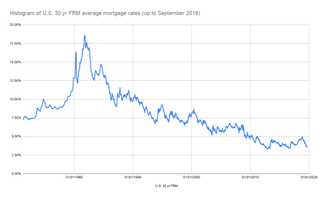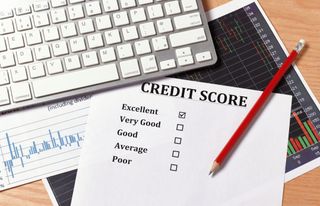Knowing when to refinance your mortgage to get the best deal on rates or to consolidate debts can be hard. Mortgage refinancing done right can greatly reduce your monthly mortgage payments while also reducing the total amount of interest you have to pay on the mortgage.
But when a mortgage refinance is misjudged it can hit your finances hard and add cost, extra monthly payments and little to no financial benefit in the long-term. So, refinancing a mortgage does carry risks.
When you are considering a cash-out refinancing mortgage for debt consolidation the risks grow. Choosing this option with a bad credit score at a time when interest rates are high could leave you with a more expensive mortgage and more debt.
This more the case if the extra loan pushed your loan-to-value score over 80%. So when considering a mortgage refinance for debt consolidation, it is best to be thorough and calculate everything – and consider other options. We'd recommend consulting with a financial professional who can provide in-depth, tailored credit repair advice before doing this.
This article gives advice about when it is a good idea to switch mortgages and when to avoid switching. By highlighting some of the best times to refinance your mortgage, we hope to help you find an amazing deal from the best mortgage refinance lenders. Everyone's situation is different so to get the most accurate advice, we recommend consulting a mortgage adviser who can give you tailored advice based upon your personal financial history.
- Best mortgage lenders
- Best refinance mortgage lenders
- Transferring mortgages
- What type of mortgage should I get?
- Mortgages for bad credit
- Best credit repair companies
- Best home equity loans
- Best debt consolidation
When is the best time to refinance a mortgage?
You will have your own reasons as to why you want to refinance your mortgage. It might be to take advantage of reduced rates, release equity, help pay off other debts, reduce monthly payments, or even increase them to reduce the overall length and costs of a mortgage.
Of course finding an interest rate that's lower than your current mortgage is the main reason you should consider to refinance your mortgage.
Many analysts, such as Freddie Mac, predict that 2019 will be a year that mortgage rates drop further, so 2019 could be a good time to refinance, particularly if you're on a higher rate.
We've taken the data on the average 30-year fix term mortgage (FTM) rates since the 1970s to give you an indication of how mortgage rates have changed over the years.

Sooner rather than later
Refinancing a mortgage earlier in its life cycle tends to pay off more. The biggest factor is the size of the loan. During the early periods of a mortgage, the sum you are borrowing is always going to be bigger. Due to this, any interest rate percentage placed on the loan is going to have a more significant effect.
Let's take an example:
Let's say you are purchasing a house and take out a fixed-rate mortgage of $200,000 for a 30 year term at a 6% percent interest rate. Five years into the term of your mortgage you have $186,375.94 outstanding on the principal (the sum you borrowed).
Let's say there is a 2% percent reduction in the interest rates and you remortgage at 4% for a term of 25 years. This has two effects. Firstly it reduces the monthly mortgage payments from $1,199.10 to $983.76. Secondly it reduces the overall interest paid from $231,676.38 to $166,806.61 (calculated from the new total interest $108,751.77 plus interest already paid $58,054.84) over the course of the original loan.
This would be a saving of $64,869.77 in total.
But if you waited 15 years before refinancing the original loan the math would change dramatically. You would owe less on your principal loan, a total of $142,583.87.
If you decided to refinance for 3% interest rates for a 15 year term, this would mean that your monthly repayments would be reduce from $1,199.10 to $984.66.
The overall interest payments would drop from $231,676.38 to $192,590.26 (new total interest of $34,654 plus interest already paid $157,935.26).
Despite the lower amount borrowed and a lower interest it would only be a saving of $39,086.12.
So, refinancing a mortgage to a lower interest rate is better when the principal is higher.
All calculations are based on The Balance's loan amortization calculator spreadsheet. We haven't accounted for any closing costs or fees in the above example. Closing costs are also percentage based, meaning larger sum will have larger costs. But even with closing costs the long-term saving should make this beneficial.
The way a mortgage divides interest rates and principal is another reason reducing interest rates is better sooner rather than later. Early on in a mortgage the payments are designed so you pay off a greater amount of interest and less principal.
What typically happens with mortgages that have a high interest rate is that during the early periods you build up less equity in your home that you would with a lower-interest mortgage. As the rates are lower, more of your monthly payment is channeled into your home.
If you compare a $200,000 loan with 6% interest against 3% with a 30-year term using the loan the monthly payments decrease but the monthly principal payments increase from $190 to $340. So a lower interest rate will also increase the rate you build equity in your home.

When your mortgage is near to a 80% loan-to-value ratio
When the principal of the loan reaches 80% of the properties original value there are two significant changes in financial circumstances that could save you money through refinancing.
The first is the loan-to-value ratio (LTV) of your mortgage.
Loan-to-value is just the ratio between the value of your property loan and the value of the property as a whole and are shown as a percentage. As it kind of represent the percentage of your home you don't own yet.
So if you want to buy a house that is worth $300,000 and you have $60,000 as a down-payment you’ll need to borrow $240,000. As this 80% of property’s value, you’ll have a 80% LTV.
An easy way to work out you LTV is to divide your outstanding loan against the value of your property and multiply it by 100.
$240,000 ÷ $300,000 = 0.8
0.8 × 100 = 80%
When you go below a 80% LTV your mortgage will be defined as low risk. This means that you will have access to better interest rates and payment options. This gives you firm ground for finding a better mortgage rate that will save you money over the term of your loan.
The second thing that happens is you don’t have to pay private mortgage insurance (PMI) on loans that are 80% of the properties total value. Refinancing might allow you to ditch these expensive payments that only there to protect lenders against non-payments. Most mortgage lenders will let you cancel PMI payments when your LTV reaches 78% of the properties original value anyway.
When thinking about the 80% LTV ratio of your original loan, it is important to know this is against the properties original value. If your property has increased in value over the course of the loan it is possible to reach 80% of the properties value sooner by a refinancing mortgage due to the properties increased value. Your new mortgage will be set against the new value of the property but the amount you owe against the property will remain the same.
So being aware of the increased value of your home could let you stop PMI payments earlier and have a LTV below 80% sooner. This will allow you access to low-risk mortgage rates. If your property has lost value, however, it would be inadvisable to refinance.
When interest rates are low
Every year mortgage rates either increase or decrease due to many factors in the economy, such as the federal reserve rate, inflation or even global factors. If you got your home loan when mortgage rates were high, you will be paying a greater amount of interest on the loan.
Applying for a rates-and-terms mortgage refinancing loan when mortgage rates fall can decrease the interest rates that you are paying on a mortgage. One thing to be check is that the mortgage rates are lower now than when you applied for the original mortgage.
Refinancing any type of mortgage during this period is beneficial. Refinancing a fixed-rate mortgage when the mortgage rates are lower than the original loan can result in lower monthly payments and overall interest. Bear in mind the closing cost is a big factor in the effectiveness of this saving.
By refinancing an adjustable-rate mortgage and changing to a fixed-rate mortgage can lock you into a low interest rate. This will protect you from having to pay high interest during periods of high inflation.
But how much should the rates drop by before refinancing?
The general advice is that you should wait for a 2% drop in mortgage rates before applying for refinancing. This is generally the level where the decrease monthly pays create a significant saving. However, this isn’t always the case and it does depend on the circumstances of the loan.
For example, a 1% drop in the mortgage rate on a million-dollar loan would be a significant saving. But for a $10,000 loan, it will be a lot less beneficial. A great way to determine whether the rate drop provides a good saving is by doing a break-even calculation.
When you have a short break-even period
A great time to refinance you mortgage is when you have a short break-even point.
The break-even period in a mortgage refinance is the amount of time the savings on monthly payment will be equal to the closing costs of the mortgage. For example, you refinance your mortgage at a closing cost of $4000, and lower your monthly payments by $300 per month. This gives you a small break-even period of 13 months. Whereas a closing cost of $3000 and a new rate the saves you $100 per month will give you a break even period of 30 months.
This just gives you an idea of when you'll start benefiting from the savings on your mortgage. The shorter the period the quicker you'll benefit. There are mortgage refinance calculators on the internet that give a deeper, more nuanced formula. We recommend having a play around with a few of these calculators to find out if refinancing now is the best option for you.
When your home has increased in value
There are significant benefits to refinancing your mortgage when your property’s value has increased. The biggest benefit of this comes when you have other debts that you wish to pay or consolidate as it allows you to get a cash-out mortgage.
A cash-out refinance mortgage is when you take out a mortgage that is larger than the one that you previously owed. For example, the original mortgage you took out was $200,000 against a house that was valued at $250,000.
Over the course of the loan you have paid off an additional $50,000, bringing the amount you owe against the property down to $150,000. The value of the property has also increased to $300,000.
Due to the lower outstanding balance, and the increased value of the property you could refinance for more than what you owe. If you borrow $170,000 you receive an additional $20,000. This can be used to pay other debt with high-interest rates or as invest in the property.
The one thing we would advise with a cash-out mortgage is to ensure you are using the extra money to invest or lower debt and not to increase your debt. Also, make sure the additional lending doesn’t increase your mortgage rates to the point that it is more beneficial to continue paying the interest on the other debt.
Refinancing for debt-consolidation purposes can be tricky and backfire if not handled correctly. We'd advise you consult with a debt-consolidation program before taking this option.

When you’ve improved your credit score
FICO score has a huge impact on the rate of your mortgages. For every 20-point increase in your fico score over 620 you can expect better rates on a mortgage. This means if your FICO score was in 620s when you first took the mortgage out but increased to 720 over the course of the loan, you could see be a huge rate reduction as you will no longer be seen as a credit risk.
Before mortgage rates go up
If you have an adjustable-rate mortgage it is important to refinance before mortgage rates increased. Adjustable-rate mortgages have interest payments that are based off an external index.
This index will increase or decrease each year. When it increases the amount of interest you pay to your mortgage lender will also increase, meaning you have higher monthly payments but no increased equity in the property.
So, if interest rates are going to rise it is best to switch to a fixed-rate mortgage while they are still low. This just means that your rates will be fixed against a low mortgage rate and not increase with the interest rates.
When you need to consolidate debt
A lot of people use cash-out refinance mortgages to consolidate debt into one payment if they have equity in their home. When done right this can be a money-saving option that will reduce monthly budgets and make living more affordable. But doing this in the right way is complicated, and is not a solution to all debt problems.
We'd advise you consult with professionals before considering this option. So if you think debt consolidation through a mortgage refinance is right for you, consult with credit repair companies or banks to make sure it is going to work. They should be able to give you advice on the best debt consolidation method for your case.
When not to refinance your mortgage
There are good times to refinance a mortgage and there are bad times when refinancing make little to no sense. You should avoid refinancing a mortgage in the following circumstances:
When you are going to move soon
An important question to ask before refinancing a mortgage is how long you intend to stay in the property. If it is a matter of two or three years, there would be very little benefit to refinancing your mortgage.
This mainly due to the fact that mortgages are front-loaded with increased interest rates. During the first three years of the new mortgage you'll mostly be paying interest while make very little payments against the principal. In such circumstances it is usually better to have a high mortgage rate, but pay off a greater amount of the principal.
When you do come to remortgage or settle the loan you'll own more of the property increasing the downpayment you can make on your next home. Whereas refinancing might reduce the proportion of the property you own at this point.
You also have to think about closing costs and your break-even period. The break-even period might be longer than you will be staying in the home. If this is the case, you are not going to benefit from lower monthly payments.
When your credit score has lowered
Just as a better credit score can decrease the interest rates you pay on the mortgage, having a worse credit score can increase the rates you pay. Generally, you need a credit score of 620 for your refinancing application to be accepted.
If your credit score has declined steeply since you first took out your home loan, we'd recommend that don't refinance. You could be charged higher rates if you do, negating any other possible benefit from refinancing.
When you can't afford the closing costs
Closing costs can be steep. Typically closing costs are around 3% of the loan. We'd recommend only adding the closing costs on to the new mortgage when you have no other choice and to pay for these upfront.
Adding the closing costs on to the mortgage would mean decreasing the equity of your home which in turn would increase your interest payments. Figure out how much closing cost you have to pay on your existing loan to work out the long-term impact this will have on a second loan if you are adding it on. Only switch if it is more cost effective in the long run.
If the extra closing costs add a great amount of interest or increase your monthly payments, than wait until you can afford to pay them from your savings.
When it costs you more than you'd save
You should only refinance a loan when the savings you'll gain outweigh the long-term cost.
As previously mentioned, mortgages are arranged so you pay a high rate of interest first with a low payment toward the principal. This means that you could end up paying more interest if you refinance too soon or too often.
Another factor to consider is the term of the mortgage. Refinancing a 30-year term ten years in the mortgage as another 30-year mortgage might make the monthly payments lower, but it will also increase the amount of total interest you are paying on the home loan.
When the interest rates are higher than your original mortgage
Remortgaging when the interest rates are higher doesn't make much sense. One of the key points to refinancing your mortgage is to get lower rates, and to reduce the interest that you are paying on your mortgage. With higher interest rates your mortgaging is only going to increase in interest payments.
When your home has lost value
If you home has lost value since the first mortgage it is unlikely that your application to refinance the mortgage will be accepted. One reason you might have trouble finding an application is because the house may no longer have enough value to cover the original debt.
In this case you are very unlikely to find a mortgage lender that is going to give a loan that has a higher value than the property is worth. Even if the loan is less then than the property's overall value finding a loan will be tricky, because it is a risky investment for the lender.

